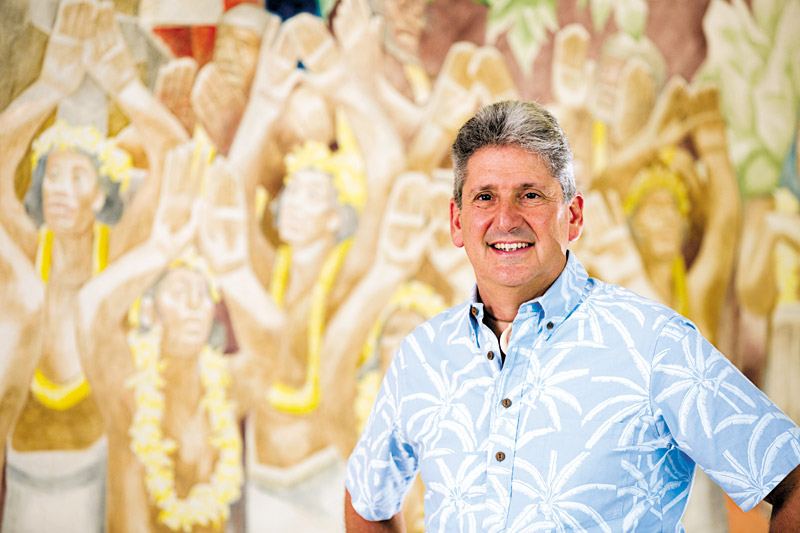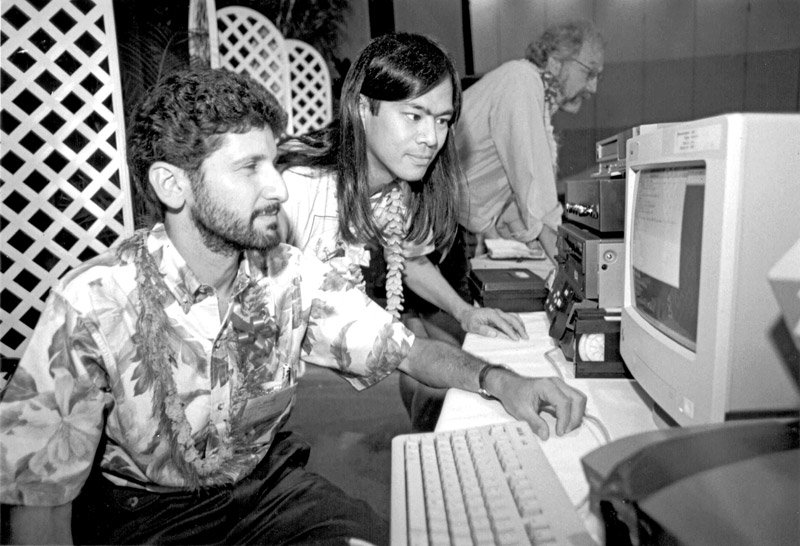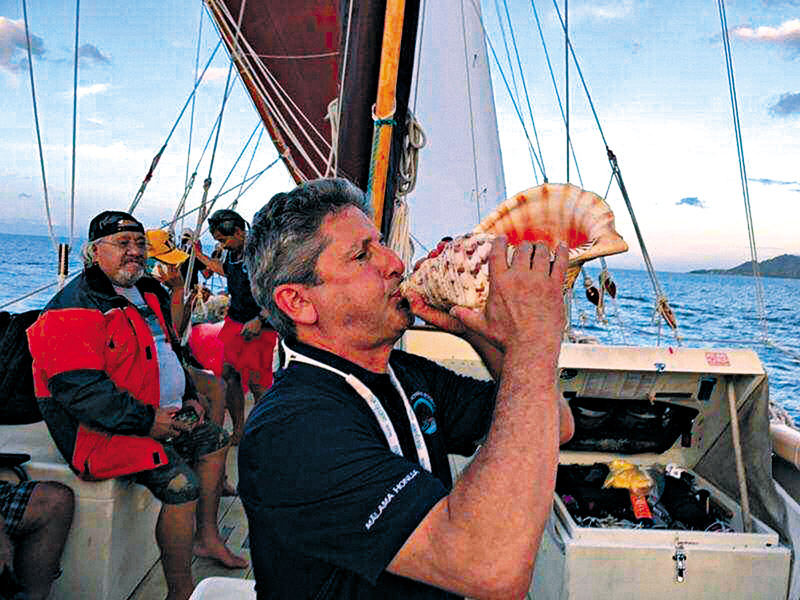The Face Of UH

Four decades of work within the University of Hawai‘i system has properly prepared president David Lassner to lead the institution forward in research, innovation and athletics.
Good things have been brewing at University of Hawai‘i, to hear president David Lassner tell it.
As the face of the university, Lassner is responsible for the strategic direction for the institution, which means working with the leadership team, heads of academic units, administrative vice presidents and more.
Guiding a system as large and far-reaching as University of Hawai‘i, though, is a daunting task — and, according to Lassner, success will come as the institution and community return to its roots.
He recently spent three weeks aboard Hōkūle‘a during the vessel’s journey from Washington, D.C., to New York, and says the experience was inspiring.
“Native Hawaiian people were, without question, the most amazing voyagers on the planet,” he says. “They were able to settle the Pacific without navigational instruments. They were doing things that the Europeans couldn’t do for literally a thousand years with instruments and huge ships.”
Lassner also cites the ability of Native Hawaiians to live sustainably on the islands as a definitive foundation for where the university system wants to head in the future, and its responsibility to the land and its people.
“I’m really inspired to see a lot of our best scientists embracing this idea in collaboration with a new generation of young scientists,” he says.
With all that’s on his plate, Lassner’s days involve a lot of hard work and dedication.
“It’s a handful, but it’s incredibly rewarding,” he adds. “It’s a pretty amazing opportunity to give back to a place that has been really good to me and that is so important to the entire state.”
Lassner entered the position of president with nearly four decades of experience within the UH system under his belt. Since starting with the establishment in 1977 on a one-year, half-time contract, he’s held positions as interim chancellor, vice president of information technology, chief information officer, educator and more.
While he’s given up the role of CIO — Garret Yoshimi holds that title now — Lassner still keeps his finger on the pulse of a handful of tech projects. He continues his work with the Maui High Performance Computing Center, Pacific Disaster Center on Maui, and high-speed data networks in Asia Pacific.
“When I shifted from being CIO to president, I didn’t really know if I would be able to let go,” he adds with a laugh. “I mean, I have decades, and my whole career was in technology.”
As the state’s only public institution, University of Hawai‘i has the distinct role of advancing innovation through research. That job, says Lassner, is a responsibility not taken lightly.
“When we look at economic development and diversification across the country, there’s always a great research university or more at the heart of it,” he explains.
He cites Silicon Valley and the funneling of research from the likes of University of California, Berkeley, and Stanford University, as well as the Boston area, which has research facilities at Harvard University, MIT and Tufts University. Even Research Triangle Park in North Carolina has a bevy of innovative ideas coming from it, thanks to University of North Carolina at Chapel Hill, North Carolina State University and Duke University.
“We have to step up as Hawai‘i’s only research university,” he adds. “That’s us.”
In addition, Lassner is a supporter of the entrepreneurial spirit and has been working with organizations like Hawai‘i Business Roundtable and various legislative leaders to diversify the state’s economy beyond tourism and military spending. He believes in the need to develop economic sectors around research, innovation and technology — all of which will serve as a foundation for business ideas.
“We now talk about our students not just getting a job, but creating jobs,” Lass-ner explains. “And it’s not just computer science and engineering. It’s across the university, just thinking about how can we be stimulating innovation and starting companies and creating employment opportunities.”
Over the years, Lassner has seen the university change the way it operates to better serve students on all islands and from all walks of life.
“That’s one of the great things about the UH system,” he says. “We have a place for every student in the state. It’s a different way of thinking about how all 10 of our campuses work together. The way we collaborate helps students move between campuses.
“I didn’t realize how dire the enrollment numbers were,” Lassner adds. “Not only had we been declining for five years, but the declines were bigger each year than the year before. We were almost falling off a cliff.”
Protocol was implemented in spring 2017, and the declined started slowing late last year. 2018, though, has been cause for celebration, as the university experienced a net increase in overall enrollment.
Lassner credits the influx to partners like the state Department of Education and its Hawai‘i P-20 college and career readiness program for high schoolers.
“What’s really remarkable about it is that the impact is so strong for students who prior to this would have been least likely to go to college — low-income or first generation,” he explains. “We really have to be working to help instill in them the idea that going to college is something you can achieve. It’s something that every student can achieve.
“There are P-20 programs in most states, but I have never encountered one in any state that is as successful and as impactful as Hawai‘i’s P-20 program.
“This is a really great institution,” Lassner adds of the UH system. “I would like the community to realize just how great a university we are. We have to get more students to attend college, including here, we’ve got to get them out faster. We have to stimulate the economy.
“Hawai‘i needs a more educated citizenry, and we’re the biggest factor in that.”
FOOTBALL FEVER
University of Hawai‘i president David Lassner is a self-proclaimed geek at heart.
He’s spent the better part of his life engaged in information sciences and got his start with the university working on the PLATO computer system, and for nearly two decades was the institution’s chief information officer.
UH football, though, has a special place in his heart. And, given the team’s play so far, he looks forward to what the rest of the season holds.
“It’s amazing to me how much football, and frankly athletics in general, really touches the community,” he says. “It’s really important when we do well, unintuitive as it seems, because it changes people’s attitude about the entire university, so I’m really excited for the success that (football coach) Nick (Rolovich) has had.”
But it’s not just the football team that’s spurring the university forward.
Lassner also credits the likes of men’s basketball coach Eran Ganot, women’s volleyball coach Robyn Ah Mow-Santos, men’s volleyball coach Charlie Wade, women’s soccer coach Michele “Bud” Nagamine and more.
“When we see them winning, it’s great for the university, and it’s great for the people of Hawai‘i,” Lassner adds.






